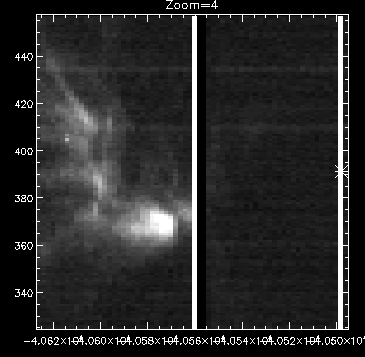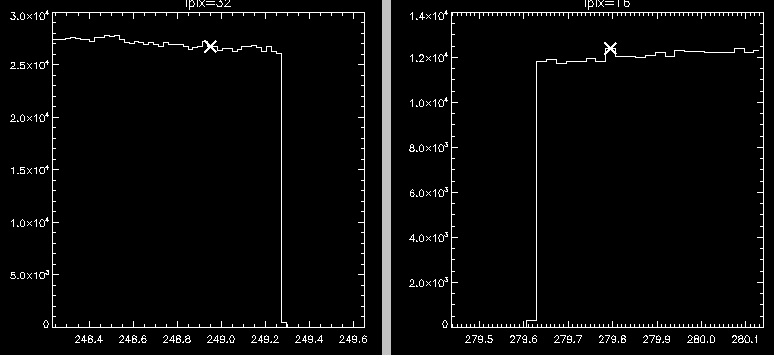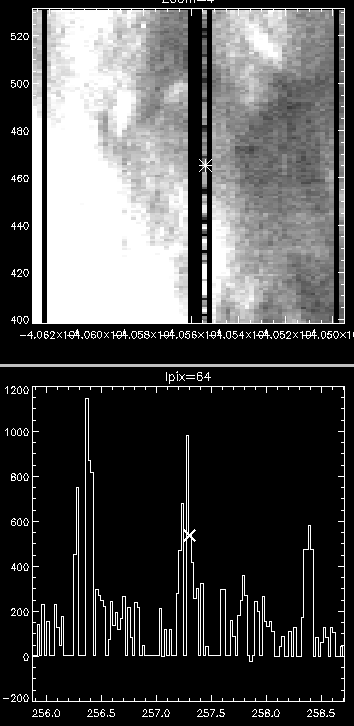Missing exposures and bright exposures - example#
The study PRY_footpoints_HI2 is an interesting test case as it has a large number of wavelength windows (23) and the windows vary significantly in size. I consider the observation obtained on 2009 December 11, 19:50.
There are 6 problem exposures: numbers 26, 57, 58, 59, 61 and 88. (Note: I'm numbering the exposures in reverse time order thus my exposure 88 is actually the 2nd exposure in time, exposure 61 is the 29th in time, etc.)
Extracting the exposure times using the getexp() method yields zero exposure times for exposures 57, 58, 59 and 88, but not 26 and 61.
The table below goes through each wavelength window and indicates the problems for the 6 exposures.
| Window | Detector | Size | 26 | 57 | 58 | 59 | 61 | 88 |
|---|---|---|---|---|---|---|---|---|
| Fe XI 182.20 | SW | 32 | OK | Dark | Dark | Dark | OK | Dark |
| Fe X 184.60 | SW | 80 | OK | Dark | Dark | Dark | OK | Dark |
| Fe XII 186.75 | SW | 40 | OK | Dark | Dark | Dark | OK | Dark |
| Fe XI 188.40 | SW | 64 | OK | Dark | Dark | Dark | OK | Dark |
| Ca XVII 192.82 | SW | 40 | OK | Dark | Dark | Dark | OK | Dark |
| Fe XII 195.48 | SW | 96 | OK | Dark | Dark | Dark | OK | Dark |
| Fe IX 197.86 | SW | 24 | OK | Dark | Dark | Dark | OK | Dark |
| S VIII 198.57 | SW | 24 | OK | Dark | Dark | Dark | OK | Dark |
| Fe XIII 202.04 | SW | 32 | OK | Dark | Dark | Dark | OK | Dark |
| Fe XIII 203.83 | SW | 32 | OK | Dark | Dark | Dark | OK | Dark |
| O V 248.95 | LW | 64 | Bright (W) | Dark | Dark | Dark | Bright (W) | Dark |
| Al VIII 250.50 | LW | 48 | Dark | Dark | Dark | Dark | Dark | Dark |
| Fe VIII 253.98 | LW | 40 | Dark | Dark | Dark | Dark | Dark | Dark |
| He II 257.30 | LW | 128 | Dark | Dark | Dark | Dark | Dark | Dark |
| Fe XVI 262.98 | LW | 24 | Dark | Dark | Dark | Dark | Dark | Dark |
| S X 264.50 | LW | 40 | Dark | Dark | Dark | Dark | Dark | Dark |
| Mg VI 268.99 | LW | 24 | Dark | Dark | Dark | Dark | Dark | Dark |
| Fe XIV 274.20 | LW | 32 | Dark | Dark | Dark | Dark | Dark | Dark |
| Mg V 276.31 | LW | 120 | Dark | Dark | Dark | Dark | Dark | Dark |
| Mg VII 278.39 | LW | 32 | Dark | Dark | Dark | Dark | Dark | Dark |
| O IV 279.80 | LW | 32 | Bright (W) | Bright (W) | Dark | Dark | Bright (W) | Bright (W) |
| Mg VII 280.75 | LW | 32 | OK | Bright | Dark | Dark | OK | Bright |
| Fe XV 284.16 | LW | 24 | OK | Bright | Dark | Dark | OK | Bright |
The descriptors for the pixels are:
OK - normal exposure
Dark - no signal at all in exposure
Bright - exposure is normal but intensities are anomalously bright at every pixel
Bright (W) - exposure is anomalously bright but spectrum is weird
The SW windows all behave the same. In particular there are only dark exposures (no bright exposures) and each of these exposures correspond to zero exposure times. The LW windows show different behavior, and also show differences amongst each other. Some details are discussed below.
The anomalously bright exposures 57 and 88 for the Mg VII 280.75 and Fe XV 284.16 windows are probably due to the fact that exposure times of 0 have been assigned to these exposures. When the intensity is computed, a division by the exposure time is performed. It seems likely that an arbitrarily small exposure time has been used giving a much higher intensity value than normal. The image below shows an image from the Mg VII 280.75 window, with the two bright exposures clearly seen. Note that the bright exposures do show normal data, only that they are anomalously bright; the image scaling below has been set to saturate the bright exposures.
 |
Only two windows show 'weird' spectra. Examples from exposure 26 are shown below:
 |
The left image is from the O V 248.95 window, the right from the O IV 279.80 window. The symmetry of the two spectra is striking. It's also noticeable that the two wavelength windows bracket 9 windows on the LW detector where all 6 exposures are dark. The two LW windows outside of these 'brackets' (Mg VII 280.75 and Fe XV 284.16) do not have all 6 exposures missing.
The spectra in the two weird windows have high values for about 75% of the window but then drop to zero. It is not clear if the bright pixels actually contain good data points as the lines in the windows are weak, however I believe they do not contain good data.
In addition to the problems above, we also note that exposure 60 which is sandwiched between two missing exposures of the LW channel shows strange spectra. Consider the He II window. The upper image below shows an image in Fe X 257.26 (which lies in the He II window). The image has been saturated, but note the four missing exposures in the center which correspond to exposures 57, 58, 59 and 61. Exposure 60 is not missing but it has a very 'stripy' pattern distinctly different to good exposures in the raster.
 |
The lower plot shows a spectrum from exposure 60 where, although spectral features can be seen, a large number of pixels have anomalously low intensity values close to zero. These are not missing pixels (in the sense of warm pixels, cosmic rays, etc. that have been flagged).
Exposure 60 shows this effect only for the LW window - the SW windows are OK. Also the Mg VII 280.75 and Fe XV 284.16 are OK as well. Note that these windows are the only LW windows for which exposure 61. It thus seems that the reason exposure 60 has problems is because it is sandwiched between two dark exposures.
